turn signal MITSUBISHI COLT 2006 Service Repair Manual
[x] Cancel search | Manufacturer: MITSUBISHI, Model Year: 2006, Model line: COLT, Model: MITSUBISHI COLT 2006Pages: 364, PDF Size: 11.65 MB
Page 7 of 364
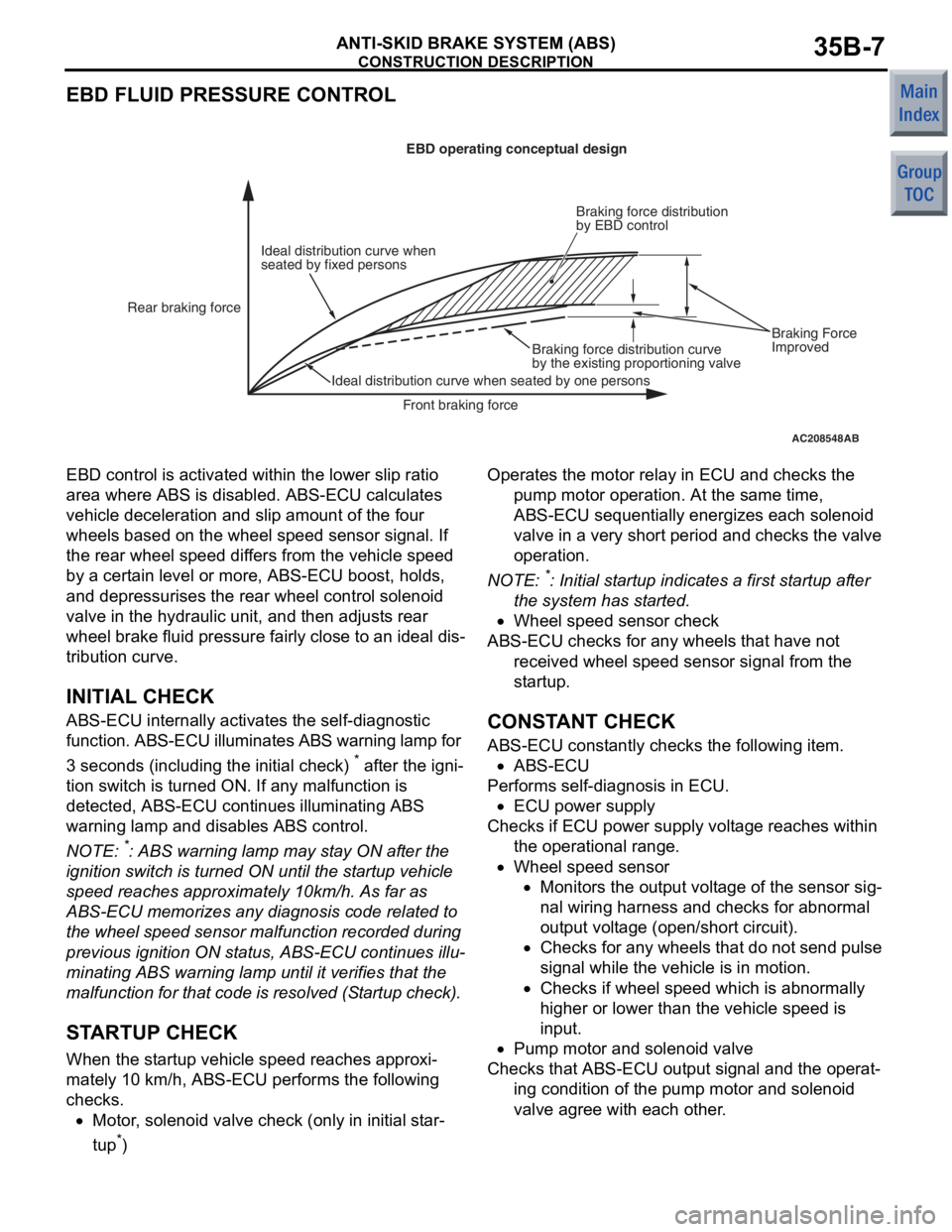
CONSTRUCTION DESCRIPTION
ANTI-SKID BRAKE SYSTEM (ABS)35B-7
EBD FLUID PRESSURE CONTROL
AC208548AB
Ideal distribution curve when
seated by fixed personsEBD operating conceptual design
Rear braking force
Ideal distribution curve when seated by one persons Braking force distribution curve
by the existing proportioning valveBraking force distribution
by EBD control
Front braking force
Braking Force
Improved
EBD control is
activate d within the lower slip ratio
area where
ABS is disab l ed. ABS-ECU calculates
vehicle
decelera t ion a nd slip amou nt of th e four
whe
e ls based on the wheel sp eed senso r signal. If
the rear
wh eel speed dif f ers f r om th e ve hicle speed
by a
cert ain level or more, ABS-ECU boost, holds,
and de
pressurises the rea r wh eel contro l so leno id
valve in the h
y drau lic unit, and then a d just s rear
whe
e l b r ake fluid pressure fa ir ly close to an ideal dis
-
tribution curve.
INITIAL CHECK
ABS-ECU inter nally activates the self-d iagno stic
function. ABS-ECU illuminates
ABS warning l a mp for
3 seconds (in
c lu ding the in itia l check)
* after th e ign i-
tion switch is turned ON. If a n y malf unction is
detected, ABS-ECU cont
inues illuminating ABS
war
n ing lamp and disables ABS cont rol.
NOTE: *: ABS warning lamp may st ay ON af ter the
ignition
switch is turned ON un til t he st artu p ve hicle
spee
d reaches approximately 10km/h . As far as
ABS-ECU memorizes any d i agn osis code related t o
the
whee l speed sen s or malfunct i on record ed d u ring
previous ignition ON st atus, ABS-ECU continues illu
-
mina ting ABS warn ing lamp until it verif i es that th e
malfunct
i on for tha t co de is resolved (S t a rtup che ck).
STARTUP CHECK
When th e st artup veh i cle sp eed re ache s app roxi-
mately 10 km/h, ABS-ECU performs the following
checks.
•Motor, solen o id valve check (onl y i n ini t ial st ar-
tup*)
Operat es the motor relay in ECU and checks the
pump motor op eratio n. At the same time,
ABS-ECU sequentially e nergizes each solenoid
valve in a ve ry sh ort perio d and ch ecks the valve
ope ration .
NOTE: *: Initia l st artu p ind i ca tes a first st artup af ter
the
system has st arted .
•Whee l speed sensor check
ABS-ECU che cks for a n y whee ls that ha ve no t
received whee l sp eed sens or signal from the
st artu p.
CONSTANT CHECK
ABS-ECU con s t antly ch ecks th e following item.
•ABS-ECU
Performs se lf-diagnosis in ECU.
•ECU power supply
Checks if ECU po we r sup p ly volt ag e reaches within
the operat ional range .
•Whee l speed sensor
•Monitors the ou tput volt age of the sensor sig-
nal wiring ha rness an d che c ks for a bnormal
output
volt ag e (ope n/sho r t circuit).
•Checks fo r any wheels tha t do n o t send pu lse
sig
nal while th e ve hicle is in motion.
•Checks if wheel spee d which is abno rmally
high
er or lo we r than the vehicle speed is
inpu
t.
•Pump mo tor and solenoid valve
Checks tha t ABS-ECU outp u t signal and t he ope rat-
ing co ndition of the pump motor an d so leno id
valve agree
with ea ch ot her .
Page 101 of 364

GENERAL INFORMATION
MULTIPOINT FUEL INJECTION (MPI) <4A9>13A-7
Throttle position sensor
and inputs it into the engine-ECU
engine-CVT-ECU
is output by this sensor, the engine-ECU
engine-CVT-ECU
feedback control.
Accelerator pedal position sensor
and inputs it into the engine-ECU
engine-CVT-ECU
is output by this sensor, which determines the
accelerator position (and the intention of the driver),
the engine-ECU
effects appropriate fuel injection and throttle valve
position controls.
Camshaft position sensorThis sensor detects the top-dead-center (TDC) of the
compression stroke of each cylinder.
Crank angle sensorThis sensor detects the crank angle and inputs it into
the engine-ECU
The engine-ECU
effects injector control and other controls in
accordance with the signals received from this
sensor.
Detonation sensorThis sensor, which contains a piezoelectric element,
detects the vibration of the cylinder block that results
from knocking. The engine-ECU
engine-CVT-ECU
of the engine from these vibrations, in order to retard
the ignition timing in accordance with the strength of
the knocks.
Alternator FR terminalThis terminal is used for detecting the duty cycle ratio
that energizes the alternator field coil.
Inhibitor switch
into the engine-CVT-ECU to determine whether the
shift lever is in the neutral position.
Stop lamp switchThis is a contact point type switch that detects how
the brake pedal is depressed.
Actuators
Engine control relayThis relay turns ON and OFF the engine-ECU
or engine-CVT-ECU
Throttle valve control servo relayThis relay turns ON and OFF the actuation power
circuit for the throttle valve control servo in the
engine-ECU
InjectorThe injectors inject fuel in accordance with the
injection signals received from the engine-ECU
Ignition coil (with power transistor)Applies ignition coil primary current intermittently in
accordance with the ignition signals received from
the engine-ECU
in order to generate high voltage for ignition.
Name Function
Page 102 of 364

GENERAL INFORMATION
MULTIPOINT FUEL INJECTION (MPI) <4A9>13A-8
Fuel pump relayControls the power supplied to the fuel pump in
accordance with the signals received from the
engine-ECU
A/C compressor relayControls the operation of the A/C compressor in
accordance with the signals received from the
engine-ECU
Purge control solenoid valveControls the flow rate of the purge air introduced into
the inlet manifold in accordance with the signals
received from the engine-ECU
engine-CVT-ECU
EGR valve (stepper motor)
signals received from the engine-CVT-ECU.
Alternator G terminalControls the amount of current generated by the
alternator in accordance with the signals received
from the engine-ECU
Cooling fan control relayControls the rotation of cooling the fan in accordance
with the signals received from the engine-ECU
Throttle valve control servoControls the throttle valve position in accordance with
the signals received from the engine-ECU
engine-CVT-ECU
Oil feeder control valveThe oil feeder control valve, which is actuated by the
signals received from the engine-ECU
engine-CVT-ECU
Oxygen sensor heater
in accordance with the signals received from the
engine-ECU
Name Function
Page 120 of 364

GENERAL INFORMATION
MULTIPOINT FUEL INJECTION (MPI) <4G1>13B-6
Camshaft position sensorThis sensor detects the top-dead-center (TDC) of the
compression stroke of each cylinder.
Crank angle sensorThis sensor detects the crank angle and inputs it into
the engine-ECU. The engine-ECU effects injector
control and other controls in accordance with the
signals received from this sensor.
Detonation sensorThis sensor, which contains a piezoelectric element,
detects the vibration of the cylinder block that results
from knocking. The engine-ECU detects only the
knocking of the engine from these vibrations, in order
to retard the ignition timing in accordance with the
strength of the knocks.
Alternator FR terminalThis terminal is used for detecting the duty cycle ratio
that energizes the alternator field coil.
Stop lamp switchThis is a contact point type switch that detects how
the brake pedal is depressed.
Actuators
Engine control relayThis relay turns ON and OFF the engine-ECU power
circuit.
Throttle valve control servo relayThis relay turns ON and OFF the actuation power
circuit for the throttle valve control servo in the
engine-ECU.
InjectorThe injectors inject fuel in accordance with the
injection signals received from the engine-ECU.
Ignition coil (with power transistor)Applies ignition coil primary current intermittently in
accordance with the ignition signals received from
the engine-ECU, in order to generate high voltage for
ignition.
Fuel pump relayControls the power supplied to the fuel pump in
accordance with the signals received from the
engine-ECU.
A/C compressor relayControls the operation of the A/C compressor in
accordance with the signals received from the
engine-ECU.
Purge control solenoid valveControls the flow rate of the purge air introduced into
the inlet manifold in accordance with the signals
received from the engine-ECU.
Alternator G terminalControls the amount of current generated by the
alternator in accordance with the signals received
from the engine-ECU.
Cooling fan control relayControls the speed of the cooling fan in accordance
with the signals received from the engine-ECU.
Throttle valve control servoControls the throttle valve position in accordance with
the signals received from the engine-ECU.
ECU
Name Function
Page 157 of 364
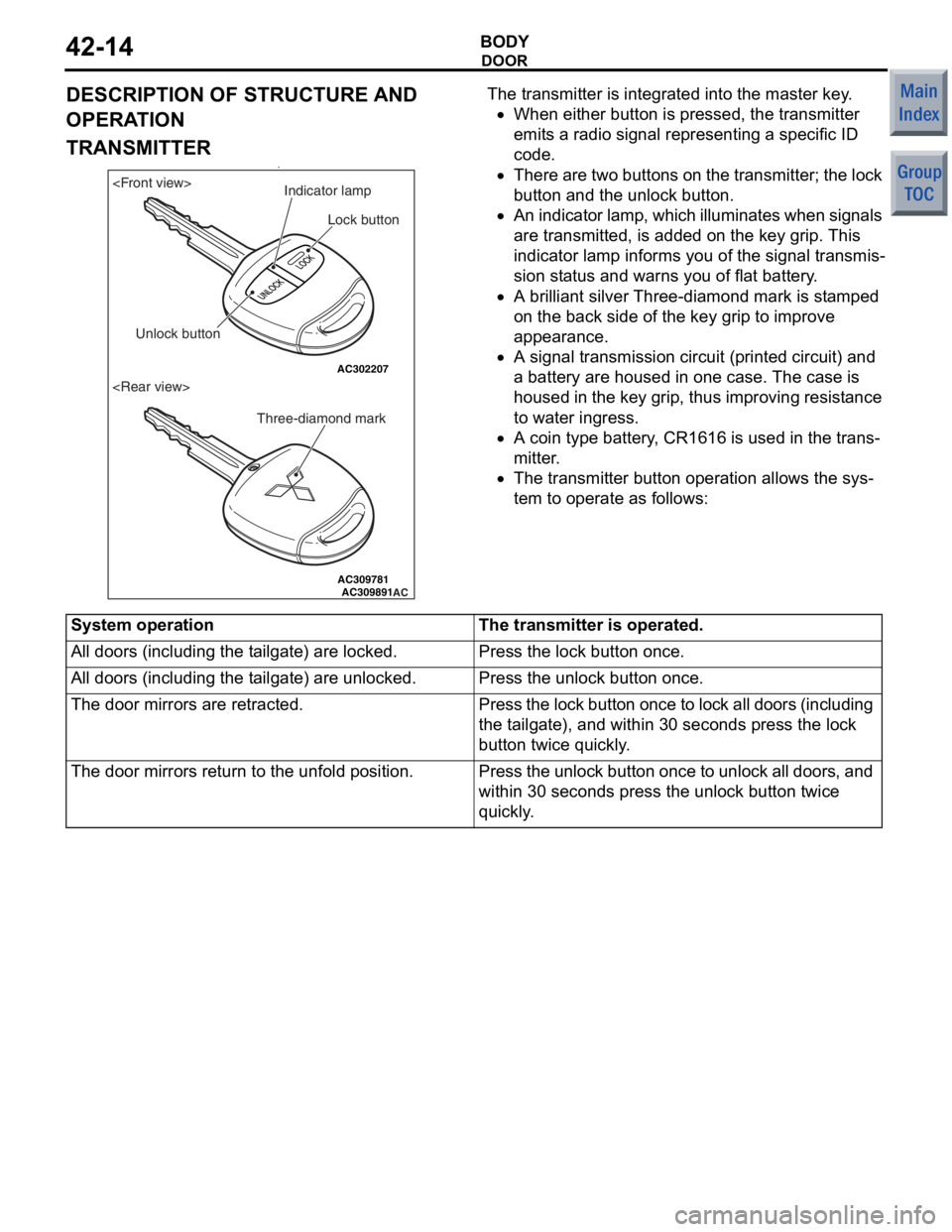
DOOR
BODY42-14
DESCRIPTION OF STRUCTURE AND
OPERATION
TRANSMITTER•
AC309781 AC309891
AC302207AC
Lock button
Unlock button Three-diamond markIndicator lamp
The tran
smitter is integra t ed in to the master key .
•When eit her butt on is pressed , the tra n smitter
emit
s a radio sig nal re prese n ting a sp ecific ID
code.
•There a r e two butto ns o n th e tra n smitte r; th e lo ck
but
ton and the u n lock bu tton.
•An indicator lamp, which illumina tes when signals
are
transmitt ed, is add ed on t he ke y grip. This
in
dicator lamp informs you of the signa l transmis
-
sion sta t us a nd warns you of flat batt e ry .
•A brilliant silver Three -d ia mond mark is st amped
on
the back side of the key grip to improve
app
earance.
•A signal transmissi on circuit (p rinted circuit ) and
a b
a ttery are ho used in on e ca se. T he ca se is
hou
sed in the key grip, thus improving re sist ance
to wat
e r ing r ess.
•A coin type b a ttery , CR1616 is used in th e trans-
mitter.
•The transmit t er butto n ope ration allows the sys-
tem to operate a s follows:
System operationThe transmitter is operated.
All doors (including the tailgate) are locked.Press the lock button once.
All doors (including the tailgate) are unlocked.Press the unlock button once.
The door mirrors are retracted.Press the lock button once to lock all doors (including
the tailgate), and within 30 seconds press the lock
button twice quickly.
The door mirrors return to the unfold position.Press the unlock button once to unlock all doors, and
within 30 seconds press the unlock button twice
quickly.
Page 176 of 364
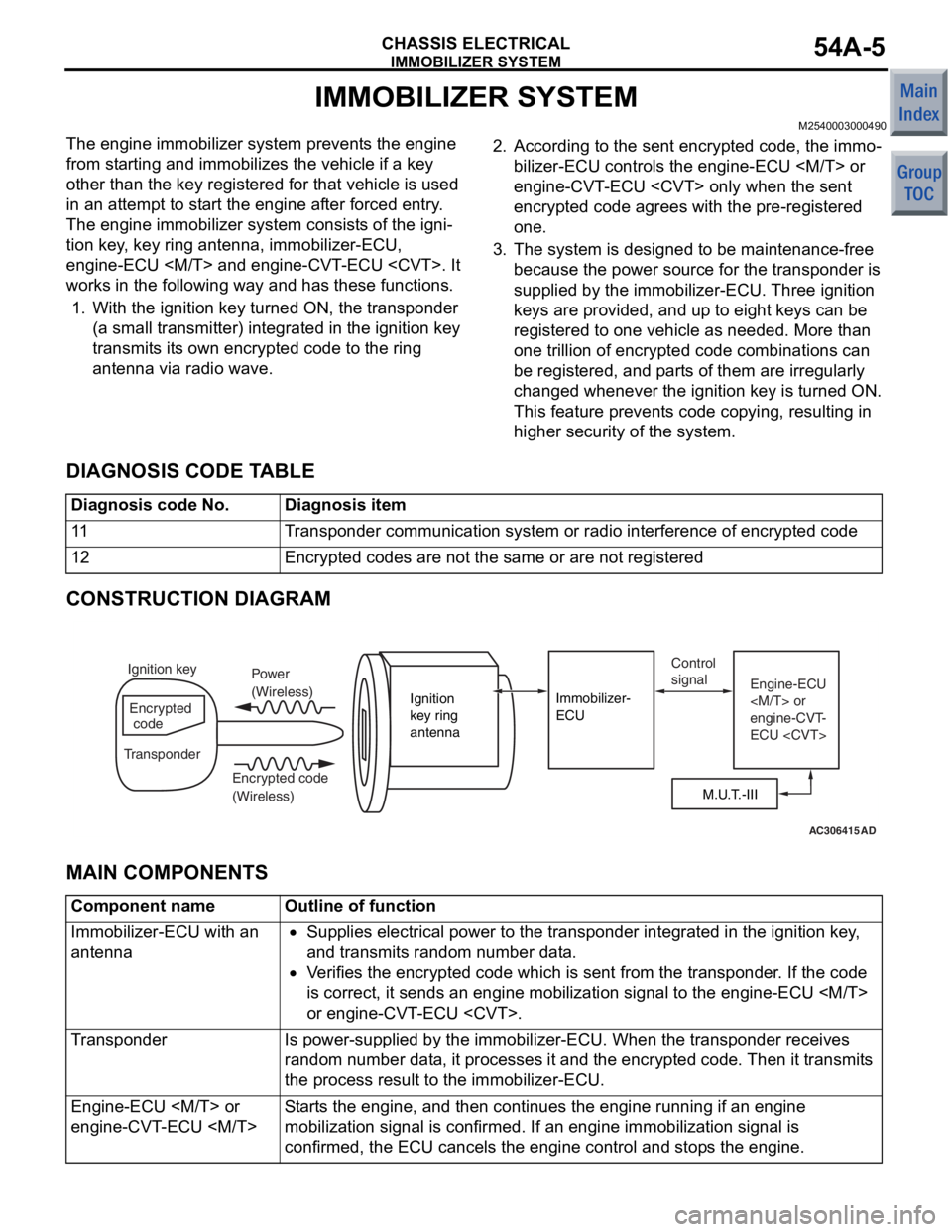
IMMOBILIZER SYSTEM
CHASSIS ELECTRICAL54A-5
IMMOBILIZER SYSTEM
M2540003000490
The engine immobilizer system prevents the engine
from starting and immobilizes the vehicle if a key
other than the key registered for that vehicle is used
in an attempt to start the engine after forced entry.
The engine immobilizer system consists of the igni
-
tion key, key ring antenna, immobilizer-ECU,
engine-ECU
works in the following way and has these functions.
1. With the ignition key turned ON, the transponder
(a small transmitter) integrated in the ignition key
transmits its own encrypted code to the ring
antenna via radio wave.
2. According to the sent encrypted code, the immo-
bilizer-ECU controls the engine-ECU
engine-CVT-ECU
encrypted code agrees with the pre-registered
one.
3. The system is designed to be maintenance-free because the power source for the transponder is
supplied by the immobi lizer-ECU. Three ignition
keys are provided, and up to eight keys can be
registered to one vehicle as needed. More than
one trillion of encrypted code combinations can
be registered, and parts of them are irregularly
changed whenever the ignition key is turned ON.
This feature prevents code copying, resulting in
higher security of the system.
DIAGNOSIS CODE TABLE
Diagnosis code No.Diagnosis item
11Transponder communication system or r adio interference of encrypted code
12Encrypted codes are not the same or are not registered
CONSTRUCTION DIAGRAM
AC306415AD
M.U.T.-III
Ignition
key ring
antenna
Immobilizer-
ECU
Ignition key
Encrypted
code
Transponder Power
(Wireless)
Encrypted code
(Wireless) Control
signal
Engine-ECU
engine-CVT-
ECU
MAIN CO MP O N E N TS
Component name Outline of function
Immobilizer-ECU with an
antenna•Supplies electrical power to the transponder integrated in the ignition key,
and transmits random number data.
•Verifies the encrypted code which is sent from the transponder. If the code
is correct, it sends an engine mobili zation signal to the engine-ECU
or engine-CVT-ECU
TransponderIs power-supplied by the immobilizer-ECU. When the transponder receives
random number data, it processes it an d the encrypted code. Then it transmits
the process result to the immobilizer-ECU.
Engine-ECU
engine-CVT-ECU
mobilization signal is co nfirmed. If an engine immobilization signal is
confirmed, the ECU cancels the engine control and stops the engine.
Page 178 of 364

LIGHTING
CHASSIS ELECTRICAL54A-7
LIGHTING
M2540004000932
EXTERIOR LAMPS
•The headlamp employs a large four-lamp type
integrated with the front turn-signal lamp and
position lamp, creating the integrity appearance
with the hood. The internal lens design looks like
a precision machine, achieving improved appear
-
ance.
•The fog lamp is standard equipped. (VRX, VR
and RALLIART version-R : Standard equipment,
LS : Option)
•The rear combination lamps are a large verti-
cal-type integrated with the tail lamp, stop lamp,
rear turn-signal lamp and back-up lamp.
•The high-mounted stop lamp is equipped as
standard in order to improve safety.
Specifications
ItemSpecification
Headlamp assemblyHeadlamp (halogen bulb)Low-beam W55 (H7)
High-beam W55 (H1)
Position lamp W5 (W5W)
Front turn-signal lamp W21 (W21W)
Fog lamp W55 (H11)
Side turn-signal lamp W5 (WY5W)
Rear combination lamp
assemblyTa i l l a m p W5 (W5W)
Stop lamp W21 (W21W)
Rear turn-signal lamp W21 (W21W)
Back-up lamp W21 (W21W)
High-mounted stop lamp W x units5 × 4 (W5W)
Licence plate lamp W5 (W5W)
NOTE: The brackets ( ) show the bulb type.
Page 179 of 364
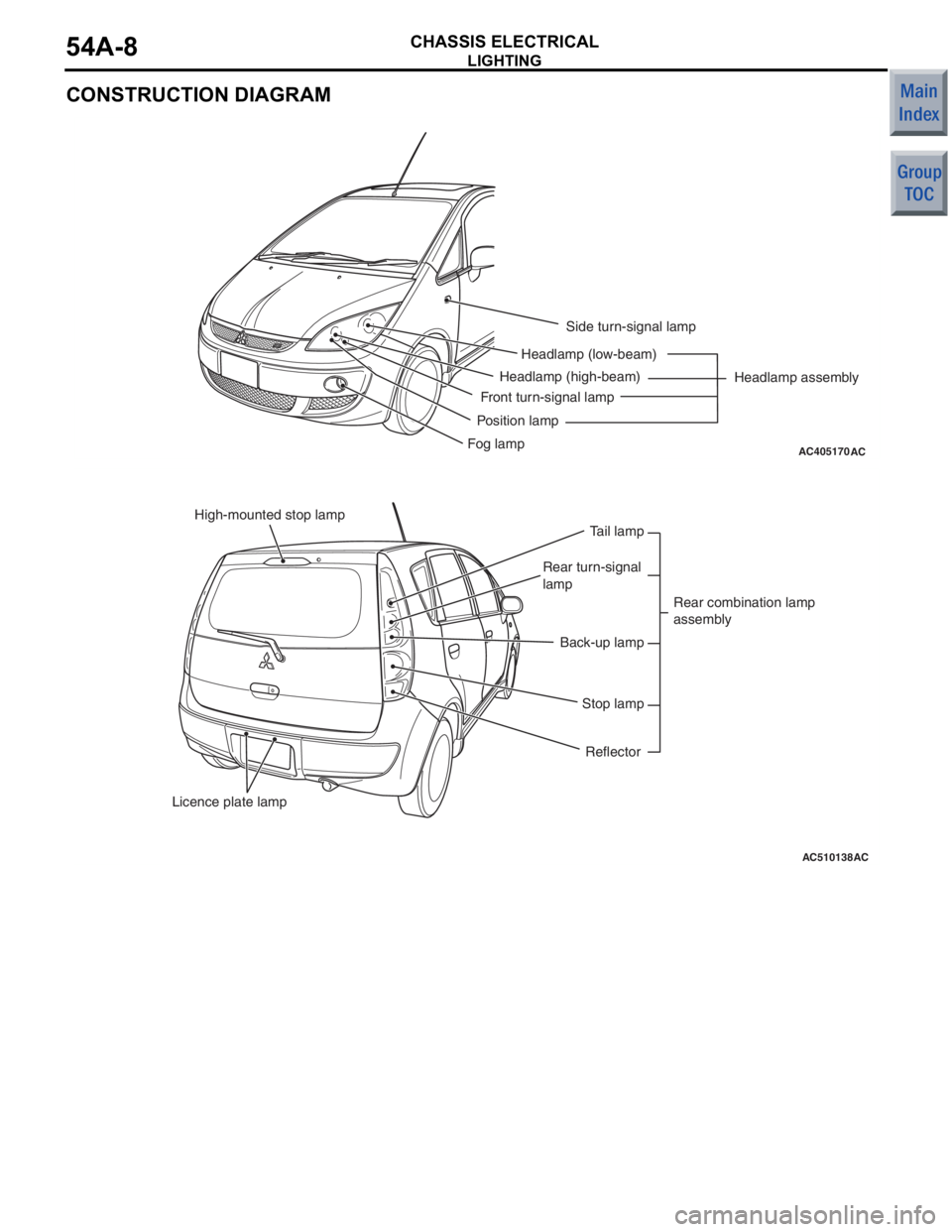
LIGHTING
CHASSIS ELECTRICAL54A-8
CONSTRUCTION DIAGRAM
AC405170
Headlamp (high-beam)
Front turn-signal lamp
Position lamp Side turn-signal lamp
Headlamp assembly
AC
Headlamp (low-beam)
Fog lamp
AC510138AC
High-mounted stop lamp
Licence plate lamp Stop lamp
Reflector
Rear turn-signal
lamp
Back-up lamp Tail lamp
Rear combination lamp
assembly
Page 181 of 364

COMBINATION METER
CHASSIS ELECTRICAL54A-10
COMBINATION METER
M2540005000894
The combination meter features large, clearly visible
analogue indicators. The meter has the speedometer
in the middle, the coolant temperature gauge at
upper right, the fuel gauge at lower right, and the
tachometer at left so that drivers can easily distin
-
guish the information from the meters. The combina-
tion meter offers the following advantages.
•The combination meter is used for air conditioner
and meter drive control to integrate ECU.
•CAN communication is used for more reliable
transmission of all gauge data and indicator lamp
input signals, such as vehicle speed, engine
RPM, and coolant temperature. For further
details on CAN, refer to GROUP 54C, CAN
P.54C-2. The signals that the combination meter
uses are described in the CAN communications
input signals table
.
•Several diagnosis functions such as the diagno-
sis code memory and actuator tests are prepared
in order to improve serviceability.
•For a brighter display at night and for a longer
useful life, all indicator lamps, warning lamps, and
illumination bulbs use LEDs.
•The indicators for the speedometer, fuel gauge,
and other gauges are driven by a stepping motor.
For further details, consult the stepping motor
section
.
•The electronic speedometer operates by receiv-
ing vehicle speed signals sent by the
engine-ECU
via the CAN.
•A large and clear LCD type odo-tripmeter is pro-
vided. The odometer continuously displays val-
ues while the tripmeter adopts a twin-trip (trip A,
trip B) function which is switched by a reset but
-
ton. In addition, clock function is incorporated.
•A fog lamp indicator lamp is provided to let the
driver know that the fog lamp is on.
•A seat belt warning lamp is installed to encourage
the driver to fasten the seat belt.
•The high-contrast meter is adopted. When the
ignition is turned ON, such as the needles and
face display are illuminated with fade-in lighting
by the LED light source.
•To further accentuate the high-contrast lighting,
the light of the high-contrast meter fades in and
fades out when the light is turned on and off
respectively.
•With the auto illumination function incorporated in
the high-contrast meter, a two-stage switching of
daytime (non-dimming) and nighttime (dimming)
is achieved. Also, the brightness can be adjusted
using the illumination control knob.
•A tail lamp indicator lamp is installed which
informs the lighting status of the tail lamps to the
driver.
Page 183 of 364
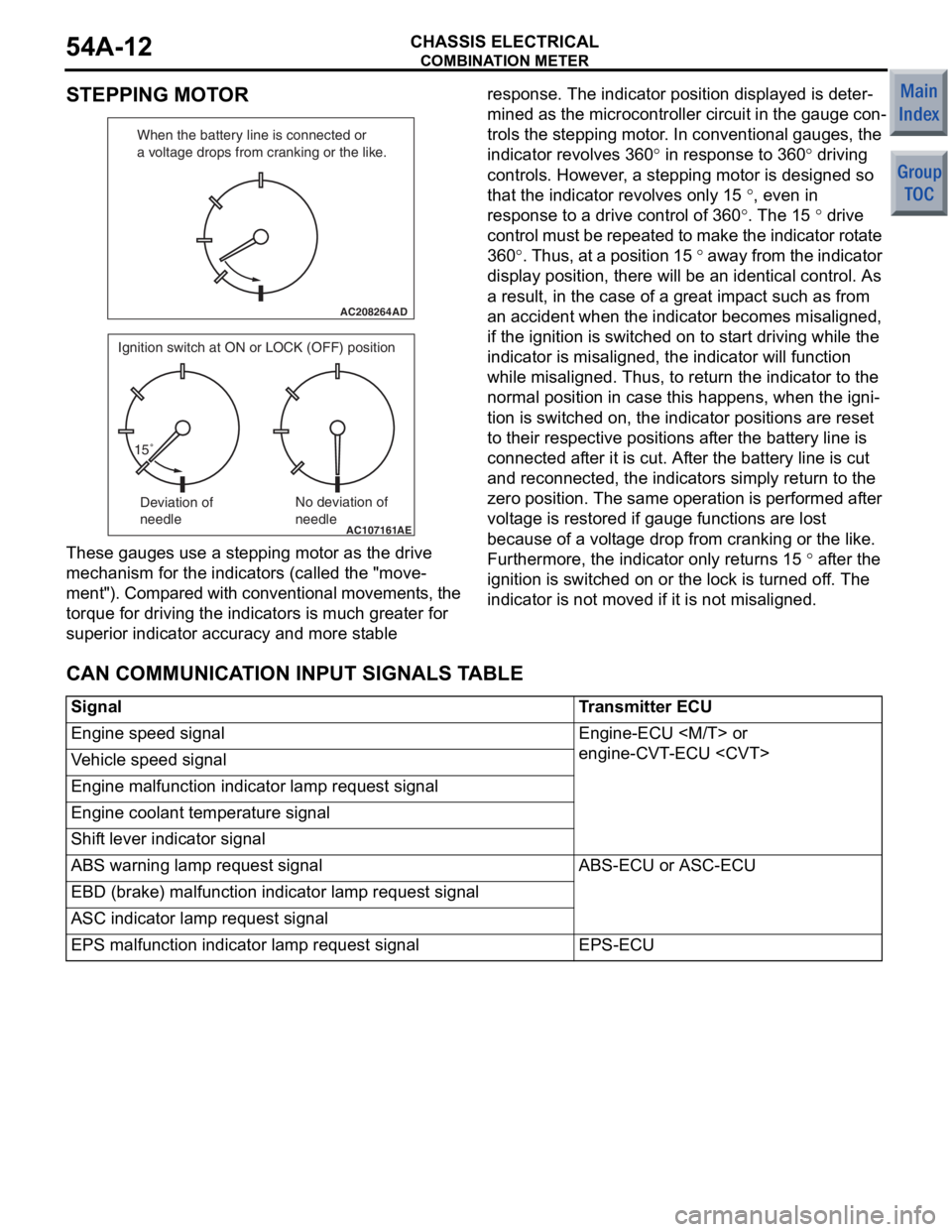
COMBINATION METER
CHASSIS ELECTRICAL54A-12
STEPPING MOTOR
AC208264
When the battery line is connected or
a voltage drops from cranking or the like.
AD
AC107161
Deviation of
needleNo deviation of
needle
15˚
AE
Ignition switch at ON or LOCK (OFF) position
These
gauge s use a stepp ing motor a s the drive
mechanism for
the indica tor s (calle d the "move
-
ment"). Compared with conventional movement s, the
torque f
o r driving the indicators is much gre a ter for
supe
rior indicator a ccu racy and more st able respo n se. The indicator po sit i on d i sp layed is dete r
-
min
ed a s t he microcon troller circuit in the gauge co n-
trols the stepping moto r . In conve n tion al gaug es, the
indicato
r revo lves 360
° in response to 3 6 0° driving
contro
ls.
Ho
we
ver
,
a ste
pping
mot
o
r is designed so
that the
ind
i
cat
o
r revolves on
ly
15
°, even in
respo
n
se
to a drive contro
l of 3
6
0
°. The 15 ° drive
c
ont
ro
l m
u
st
be
rep
eat
ed
t
o
ma
ke
th
e
ind
i
cat
o r rot a t e
36
0
°. Th us , at a po sit i o n 15 ° a w a y fr om th e in dicat o r
display positio
n, there
will be an iden tica l control. As
a resu
lt, in the
case of a
great imp a ct such as from
an accide
nt wh
en the indicator becomes misalign ed,
if the
ignition
is
switched o
n
to st art driving while t he
indicato
r is
misaligned,
the indicator will fu nction
wh
ile
misaligned.
Thus, to retu rn the indicator to the
norma
l position in
case this ha ppens, when the ig ni
-
tion is switched on , the indicator p o sitions are re set
to their respective
position s af ter th e batte ry line is
conn
ected af ter it is cut. Af ter th e batte ry line is cut
and reconne
cted , the indicators simply retu rn to th e
zero
positio n. Th e same ope ration is pe rforme d af ter
volt
ag e is resto r ed if gauge functions are lost
beca
u se o f a volt age d r op from cra n king or t he like.
Furthermore, t
he in dicator only re turns 15
° after the
ignition
is switched on
or the
lock is turne
d
of f. The
indicato
r is
not moved
if it is not misa
lig
ned.
CAN COMMUNICA TION INPUT SIGNALS T ABLE
SignalTransmitter ECU
Engine speed signalEngine-ECU
engine-CVT-ECU
Vehicle speed signal
Engine malfunction indicator lamp request signal
Engine coolant temperature signal
Shift lever indicator signal
ABS warning lamp request signalABS-ECU or ASC-ECU
EBD (brake) malfunction indicator lamp request signal
ASC indicator lamp request signal
EPS malfunction indicator lamp request signalEPS-ECU